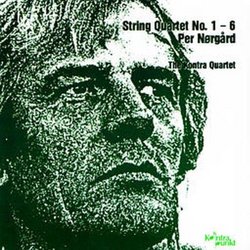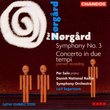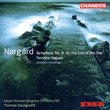| All Artists: The Kontra Quartet Title: String Quartets 1-6 Members Wishing: 0 Total Copies: 0 Label: Kontrapunkt Original Release Date: 1/1/2005 Re-Release Date: 1/1/2010 Album Type: Import Genre: Classical Style: Chamber Music Number of Discs: 1 SwapaCD Credits: 1 UPC: 716043201525 |
Search - The Kontra Quartet :: String Quartets 1-6
CD DetailsSimilar CDs |
CD ReviewsFrom Sibelian complexity to psychadelia and beyond, six fasc Christopher Culver | 12/09/2008 (5 out of 5 stars) "Per Norgard's first six string quartets cover a wide range of the composer's output, from the "Nordic" universe of the 1950s to the "psychadelic" period of the late 1960s and the "multidimensional" music of the 1980s (the composer strangely wrote no quartets during his "hierarchical" phrase of the 1970s). On this Kontrapunkt disc, now regrettably hard to find, they are performed by the Kontra Quartet, a Danish ensemble whose first violinist Anton Kontra has long been closely affiliated with Norgard's music. The other members of the quartet are Boris Samsing on second violin, Peter Fabricius on viola, and Morten Zeuthen on cello.
The String Quartet No. 1 "Quartetto Breve" op. 3 (1952) is indeed short, clocking in at just seven minutes. A student work, it shows a clear influence from the then 19 year-old composer's teacher Vagn Holmboe. The String Quartet No. 2 "Quartetto Brioso" op. 21 is a revision of the First written after the composer had discovered the remarkable techniques of Jean Sibelius. At 20 minutes, the Second is much longer, and a complex Sibelian flow reigns over the piece more than Holmboe's calm neo-classical stylings. The Second will appeal to those who have an especial love for Norgard's "Nordic period" of the 1950s, as it resembles other grand works of that era like "Constellations" for strings. The String Quartet No. 3 "Three Miniatures" (1959) shows Norgard leaving behind the Nordic universe for more original creations, though retaining his perennial interest in "interference" between constrasting musical planes. Here each member of the quartet repeats his own little melody, but a different number of times from the others, leading to constantly changing music based on just a few simple building blocks. This is a very transitional work, and the composer had not yet found his footing in his new modernism. That was to soon change, however. The following two works belong to that time in the late 1960s where Norgard's music was marked by total chromaticism and the "infinity series", the fractal process which he discovered at the beginning of the 1960s. The String Quartet No. 4 "Dreamscape" (1969), also know as the Quartet in Three Spheres, has the live performers interacting with two tape parts prepared before hand. It loses some of its novel ambience when heard from CD, where one cannot tell which is the live performance and which is the recording, but its eerie undramatic moods make for engaging listening, and then the moment where the string quartet and the tape part all play at the same time, thickening the texture completely, is quite nice. In the String Quartet No. 5 "Inscape" (1969), the composer uses a scale of microtones with a compass of only a minor third, B to D on the piano. Within this seemingly limited pitch space, Norgard discovers a world of sound as full of possibilities as any other. Hints of Norgard's major discovery, the infinity series, pop up on this weird scale. In the last movement, the soundworld opens up into a traditional chromatic scale with joyous dance rhythms, and then the work ends. It was over 15 years before he wrote another work in this genre, and the String Quartet No. 6 "Tintinnabulary" (1986) sees him active in a different stylistic period entirely. Here Norgard's interests in tuning and the ways of constructing diatonic scales are in the spotlight. Hidden throughout the work, and finally heard clearly in the last movement is the 12, the most basic of the "tone lakes". These are a new fractal process Norgard discovered, where a special series of notes is heard to fluctuate between two different keys, and in between any of the notes in the series one can discover an infinite number of new series. Norgard was to present this concept in even vaster form in the Violin Concerto No. 1 "Helle Nacht". My one big complaint about this disc is that each string quartet is put on one big single track instead of each movement getting a track. There are usually noticeable pauses between movements, though, so it's not entirely impossible to understand the structure of the quartets. When I first began thinking about this disc and formulating a review, I was inclined to be somewhat critical of Norgard as a composer of string quartets, saying that this was a genre in which he doesn't excel as much as other composers like Kurtag or Bartok. But that was because I remained so preoccupied by his fantastic orchestral works that I couldn't give these quartets a fair hearing. Granted, the orchestral works might be more immediately accessible, but I would indeed now place a few of these string quartets among Norgard's finest works." |






